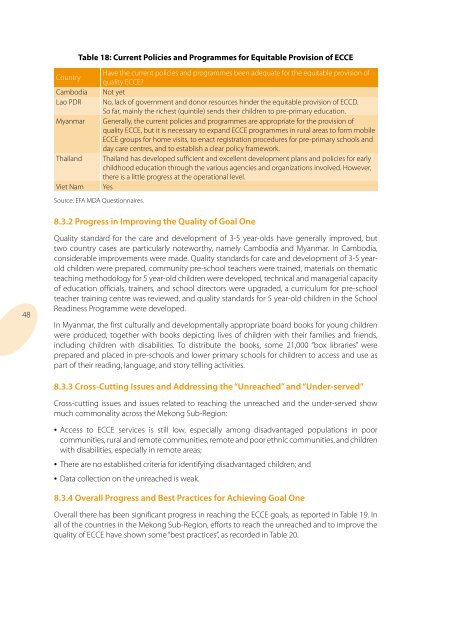Asia and the Pacific Education for All (EFA) mid-decade assessment ...
Asia and the Pacific Education for All (EFA) mid-decade assessment ...
Asia and the Pacific Education for All (EFA) mid-decade assessment ...
Create successful ePaper yourself
Turn your PDF publications into a flip-book with our unique Google optimized e-Paper software.
Country<br />
Cambodia<br />
Lao PDR<br />
Myanmar<br />
Thail<strong>and</strong><br />
Viet Nam<br />
Table 18: Current Policies <strong>and</strong> Programmes <strong>for</strong> Equitable Provision of ECCE<br />
Source: <strong>EFA</strong> MDA Questionnaires.<br />
Have <strong>the</strong> current policies <strong>and</strong> programmes been adequate <strong>for</strong> <strong>the</strong> equitable provision of<br />
quality ECCE?<br />
Not yet<br />
No, lack of government <strong>and</strong> donor resources hinder <strong>the</strong> equitable provision of ECCD.<br />
So far, mainly <strong>the</strong> richest (quintile) sends <strong>the</strong>ir children to pre-primary education.<br />
Generally, <strong>the</strong> current policies <strong>and</strong> programmes are appropriate <strong>for</strong> <strong>the</strong> provision of<br />
quality ECCE, but it is necessary to exp<strong>and</strong> ECCE programmes in rural areas to <strong>for</strong>m mobile<br />
ECCE groups <strong>for</strong> home visits, to enact registration procedures <strong>for</strong> pre-primary schools <strong>and</strong><br />
day care centres, <strong>and</strong> to establish a clear policy framework.<br />
Thail<strong>and</strong> has developed sufficient <strong>and</strong> excellent development plans <strong>and</strong> policies <strong>for</strong> early<br />
childhood education through <strong>the</strong> various agencies <strong>and</strong> organizations involved. However,<br />
<strong>the</strong>re is a little progress at <strong>the</strong> operational level.<br />
Yes<br />
8.3.2 Progress in Improving <strong>the</strong> Quality of Goal One<br />
48<br />
Quality st<strong>and</strong>ard <strong>for</strong> <strong>the</strong> care <strong>and</strong> development of 3-5 year-olds have generally improved, but<br />
two country cases are particularly noteworthy, namely Cambodia <strong>and</strong> Myanmar. In Cambodia,<br />
considerable improvements were made. Quality st<strong>and</strong>ards <strong>for</strong> care <strong>and</strong> development of 3-5 yearold<br />
children were prepared, com mun ity pre-school teachers were trained, materials on <strong>the</strong>matic<br />
teaching method ology <strong>for</strong> 5 year-old children were developed, technical <strong>and</strong> managerial capacity<br />
of education officials, trainers, <strong>and</strong> school directors were upgraded, a curriculum <strong>for</strong> pre-school<br />
teacher training centre was reviewed, <strong>and</strong> quality st<strong>and</strong>ards <strong>for</strong> 5 year-old children in <strong>the</strong> School<br />
Readiness Pro gramme were developed.<br />
In Myanmar, <strong>the</strong> first culturally <strong>and</strong> developmentally appropriate board books <strong>for</strong> young children<br />
were produced, toge<strong>the</strong>r with books depicting lives of children with <strong>the</strong>ir families <strong>and</strong> friends,<br />
including children with disabilities. To distribute <strong>the</strong> books, some 21,000 “box libraries” were<br />
prepared <strong>and</strong> placed in pre-schools <strong>and</strong> lower primary schools <strong>for</strong> children to access <strong>and</strong> use as<br />
part of <strong>the</strong>ir reading, language, <strong>and</strong> story telling activities.<br />
8.3.3 Cross-Cutting Issues <strong>and</strong> Addressing <strong>the</strong> “Unreached” <strong>and</strong> “Under-served”<br />
Cross-cutting issues <strong>and</strong> issues related to reaching <strong>the</strong> unreached <strong>and</strong> <strong>the</strong> under-served show<br />
much commonality across <strong>the</strong> Mekong Sub-Region:<br />
• Access to ECCE services is still low, especially among disadvantaged pop u la tions in poor<br />
communities, rural <strong>and</strong> remote communities, remote <strong>and</strong> poor ethnic com mun ities, <strong>and</strong> children<br />
with disabilities, especially in remote areas;<br />
• There are no established criteria <strong>for</strong> identifying disadvantaged children; <strong>and</strong><br />
• Data collection on <strong>the</strong> unreached is weak.<br />
8.3.4 Overall Progress <strong>and</strong> Best Practices <strong>for</strong> Achieving Goal One<br />
Overall <strong>the</strong>re has been significant progress in reaching <strong>the</strong> ECCE goals, as reported in Table 19. In<br />
all of <strong>the</strong> countries in <strong>the</strong> Mekong Sub-Region, ef<strong>for</strong>ts to reach <strong>the</strong> unreached <strong>and</strong> to improve <strong>the</strong><br />
quality of ECCE have shown some “best practices”, as recorded in Table 20.

















